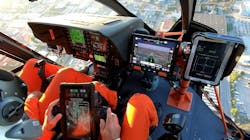Airbus flies a fully automated helicopter with a tablet
MADRID - Airbus in Toulouse, France, announced its successful test of a new simplified human-machine interface (HMI) along with advanced autonomous features through a project code-named Vertex. These technologies, developed by Airbus UpNext, are controlled by a touchscreen tablet and aim to simplify mission preparation and management, reduce helicopter pilot workload, and further increase safety.
The Airbus Helicopters’ FlightLab flew fully automated from lift-off, taxi, takeoff, cruise, approach and then landing during a one-hour test flight by following a predefined route. During this flight, the pilot monitored the system which can detect unforeseen obstacles and automatically recalculate a safe flight path. Whenever necessary the pilot can easily override the controls through the tablet and resume the mission afterwards. The flight test period ran from 27 Oct. through 22 Nov. at Airbus Helicopters’ facility in Marignane, France.
“This successful demonstration of a fully autonomous flight from takeoff to landing is a great step towards the reduced pilot workload and simplified HMI that the Airbus Urban Air Mobility team intends to implement on CityAirbus NextGen. It could also have immediate applications for helicopters in low-level flights close to obstacles thanks to the information provided by the lidars on board,” said Michael Augello, CEO of Airbus UpNext.
The Vertex project works on autonomous technologies, utilizing vision-based sensors and algorithms for situational awareness and obstacle detection; fly-by-wire for enhanced auto-pilot; and an advanced human-machine-interface. Airbus says that the combination of these technologies will enable a system that can manage navigation and route preparation, automatic take-off and landing, as well as following a predefined flight path.
